The automotive industry is undergoing a revolution, with hybrid and electric vehicles (HEVs and EVs) leading the charge toward sustainable mobility. Driven by greenhouse gas emission reduction efforts, this transition is altering the way vehicles are conceptualised or powered. Concurring to Deloitte estimates, demand for EVs could grow at an estimated compound annual growth rate of 29% during this decade. By 2030, they may represent 31.1 million sales units — nearly one-third of new car market sales all across the globe! This growth underscores the significance of innovation in EV components to build a sustainable, low-emission transportation ecosystem.
Electronic systems are essential for the functioning of electric vehicles (EVs) and hybrid electric vehicles (HEVs). They manage everything from energy distribution to vehicle monitoring. Important parts, such as battery management systems (BMS), help use power efficiently to prolong battery life. Inverters and converters also play a role by directing electricity to motors, ensuring smooth operation. Together, these powertrain electronics now account for roughly a quarter of EV production costs, highlighting their importance in reaching sustainability goals for the automotive industry.
Electronics also enable advanced safety features, including Advanced Driver Assistance Systems (ADAS). ADAS utilises sensors, cameras, and radar technology to continuously monitor surroundings and assist drivers — an invaluable feature for providing premium and safe driving experiences in electric vehicles. MarketsandMarkets forecasts significant growth in ADAS usage, with unit shipments increasing from 334 million in 2024 to over 655 million by 2030, reflecting demand for safer yet smarter transportation in an increasingly automated transportation landscape.
Energy efficiency remains one of the greatest hurdles facing electric vehicles (EVs), given current battery technology’s capacity and cost constraints. To address these limitations, modern EVs utilise high-efficiency converters and inverters designed to maximise energy use, helping extend driving range while alleviating “range anxiety.” Furthermore, innovative techniques like regenerative braking convert lost braking energy back into useful power. Research indicates this technique could save up to 70% of lost energy during the braking process, decreasing both charging frequency and energy demand and contributing significantly toward sustainability goals.
In addition to energy efficiency, the utilisation of sustainable materials in vehicle production is very important for minimising environmental impact. With the growing request for EVs, manufacturers have started to turn towards recyclable and lightweight materials, such as aluminium and carbon composites. Such lightweight materials reduce vehicle weight, ultimately improving energy efficiency. A report by the Office of Energy Efficiency & Renewable Energy shows that a 10% reduction in vehicle weight can improve energy efficiency by 6-8%, demonstrating the link between material choice and sustainability.
Connectivity adds another level of sustainability to EV driving experiences. Connected vehicles utilise telematics and IoT systems for real-time data on battery health, traffic flow, and other metrics so drivers can make more energy-efficient choices. Furthermore, Vehicle-to-Grid (V2G) technology connects electric vehicles directly with electrical grids for smart charging that reduces peak demand while cutting costs.
A global shift toward sustainable mobility is supported by industry collaboration among automakers, technology providers, regulatory bodies, and governments worldwide. Governments all around the world are also setting ambitious standards and offering incentives in order to support the adoption of electric vehicles (EVs). For instance, European Union governments have set the aim to phase out fossil-fuelled vehicles entirely by 2035 while encouraging innovation in battery chemistry and energy management — increasing battery energy density while addressing consumer concerns regarding driving range and charging times through emerging technologies such as solid-state batteries that promise increased performance potential.
All things considered, the revolution in electric vehicles (EV) and hybrid electric vehicles (HEV) marks not only a passing trend but also a seismic turn toward a sustainable future! Driven by innovative technology and rigorous rules, the sector is sprinting ahead to open the road for an unheard-of period of clean transportation.

